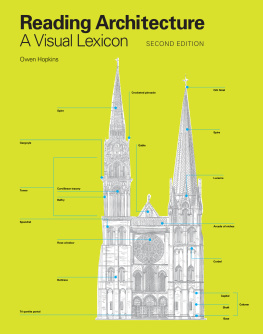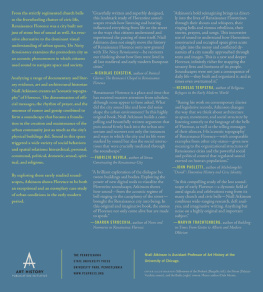FLORENCE
Copyright 2015 by Richard J. Goy
All rights reserved.
This book may not be reproduced, in whole or in part,
in any form (beyond that copying permitted by
Sections 107 and 108 of the U.S. Copyright Law
and except by reviewers for the public press),
without written permission from the publishers.
Designed by Emily Lees
Printed in China
Library of Congress Cataloging-in-Publication Data
Goy, Richard J. (Richard John), 1947
Florence : a walking guide to its architecture / Richard J. Goy.
pages cm
Includes bibliographical references and index.
ISBN 9780300209877
1. Architecture Italy Florence Tours. 2. Walking Italy Florence Tours.
3. Florence (Italy) Buildings, structures, etc. Tours. 4. Florence (Italy) Tours.
I. Title.
NA1121.F7G68 2015
720.945511 dc23
2014043044
A catalogue record for this book is available from the British Library
Frontispiece: The city centre from San Miniato, with the Palazzo Vecchio (left), Cappelle Medicee (centre) and the cathedral group (right centre)
Contents

Preface
The basic purpose of this book is fairly simple: to provide a succinct, portable and comprehensive guide to the architecture of Florence. While there are numerous popular guidebooks to the city, only the excellent and authoritative Guida rossa, published by the Touring Club Italiano (TCI), provides a reliable and comprehensive guide to the citys architecture; unfortunately, it is available only in Italian, and thus of little use to many English-speaking visitors. There are a couple of other helpful pocket guides, Guida di Firenze architettura by Carlo Cresti and others (first edn, 1992), and also Guido Zucconis Firenze: guida allarchitettura (1995); both are extremely useful, albeit selective, and again both published in Italy.
There thus appeared to me to be a gap, a raison dtre for such a guide. The intention is to be as comprehensive as space allows, and I have taken the history of Florences architecture from the Romanesque period up to the recent past, including, for example, the groundbreaking new childrens hospital at Careggi, completed in 2008.
In almost no other city, however, with the possible exception of Rome, is architecture so closely intertwined with the other arts as it is in Florence; from the Medicean sculptures in the Loggia dei Lanzi to Fra Angelicos frescoes at San Marco, these three arts are indivisibly interrelated; I have therefore made at least a brief reference to most of the many remarkable treasures of art and sculpture with which the city is extraordinarily richly endowed.
Florence is so immediately and universally recognised as the birthplace of the Renaissance, and thus of many central elements of modern western civilisation, that many people are unaware of the fact that the city had a pre-Renaissance of great cultural importance more than a century earlier than the buildings of Brunelleschi, the paintings of Botticelli and the texts of Alberti and Ficino. One could, for example, cite the 1290s, the decade in which the great new cathedral of Santa Maria del Fiore and the Palazzo Vecchio were both begun; when Giotto painted and when Dante was writing the Vita nuova; or the 1340s and 1350s, when Boccaccio and Petrarch wrote, and when the elegant campanile of the cathedral was rising. High medieval Florence was a wealthy, refined city full of extraordinary creative gifts a century before the broader rediscovery of the classical world and the patronage of Cosimo de Medici, pater patriae.
If this small guide has two primary functions, one is therefore to broaden the visitors appreciation of the whole millennial span of the citys architectural history both before and after the Renaissance; the other is to try and persuade the visitor to explore, to stray beyond the traditional highlights of the Uffizi, the Accademia, the cathedral and the Palazzo Pitti, essential though they are; also to appreciate the medieval fabric of Borgo Santi Apostoli and the homonymous church; the massive power of the citys medieval gates; the splendid Baroque faade of San Gaetano; the neo-Byzantine orientalism of the synagogue; the Art Nouveau Galleria Vichi; and the remarkable Modern Movement railway station of Santa Maria Novella. There is not a single major architectural style from the last millennium that does not have some representation in the city and its surroundings, and they can all be sought and admired.
Following the principles of my earlier guide to Venice, I have again omitted the type of tourist information usually found in popular guides. There are two reasons: first, that of space, since its omission permits the maximum amount of architectural information within a reasonably compact format. Secondly, because such information almost always has some built-in obsolescence, and any references to hotels and restaurants or the opening hours of museums are all subject to change.

Courtyard of a house on Borgo Santa Croce

The Rucellai Monument at San Pancrazio by Leon Battista Alberti, circa 14657
Acknowledgements
I have accumulated a number of debts while compiling this guide, which I am delighted to acknowledge. At a practical level, I must thank all at the Hotel Universo, for their excellent accommodation and friendly, helpful assistance; to the restaurant Da Guido for providing splendidly robust local cuisine; and to Wilma and her colleagues at the bar Le Cappelle Medicee for their warm hospitality.
Special thanks are due to Professore Architetto Romano del Nord and, in particular, to his colleague Architetto Cristina Donati, both at CSPE, for taking time to give me a guided tour of their wonderful new childrens hospital at Careggi; the illustration of their new hospital entrance block at Careggi is reproduced with their kind permission: copyright CSPE; IPOSTUDIO; Elio di Franco and photographer Alessandro Ciampi. All the other photographs are by me.
Once again, warmest thanks are due to Gillian Malpass, Emily Lees and Hannah Jenner at Yale, for supporting and encouraging my efforts, and for bringing them once again to such elegant fruition.
Finally, thanks once more to Barbara and Catherine, and to Angela, all of whose enthusiastic appreciation of the many delights of Florence now matches my own. No visit is now complete without a family picnic up at Fiesole. This book is therefore dedicated to them.

Santa Maria Novella: the Chiostro Verde
Introduction
A POLITICAL OUTLINE
The Roman city of Florentia was established by the emperor Augustus (27 BCAD 15) and this settlement is discussed briefly under the urban history section below. The Roman town flourished, such that by the reign of Diocletian (AD 245313) Florentia was the capital of the Roman region of Tuscia et Umbria, with borders very similar to those re-established by the Medici many centuries later. Like much of northern and central Italy, the city was badly damaged by the series of barbarian invasions following the decline of the Roman Empire, notably that of the Goths in AD 405. They were defeated, however, by the Florentine leader Stilicone, who re-established Christianity here, after the earlier attempt by (St) Miniato, who had been martyred in AD 250.
Next page














